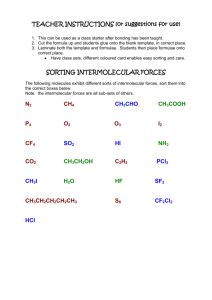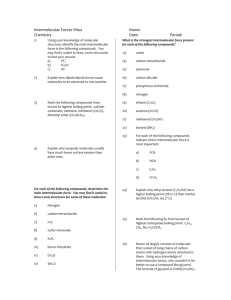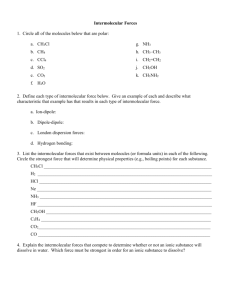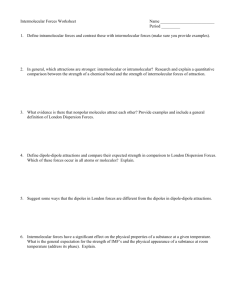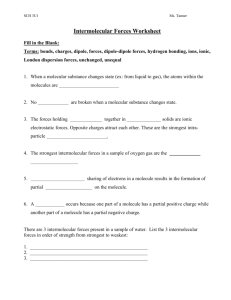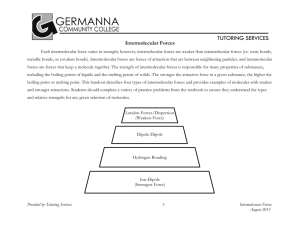DISCOVERY Intermolecular Forces and Physical Properties
advertisement
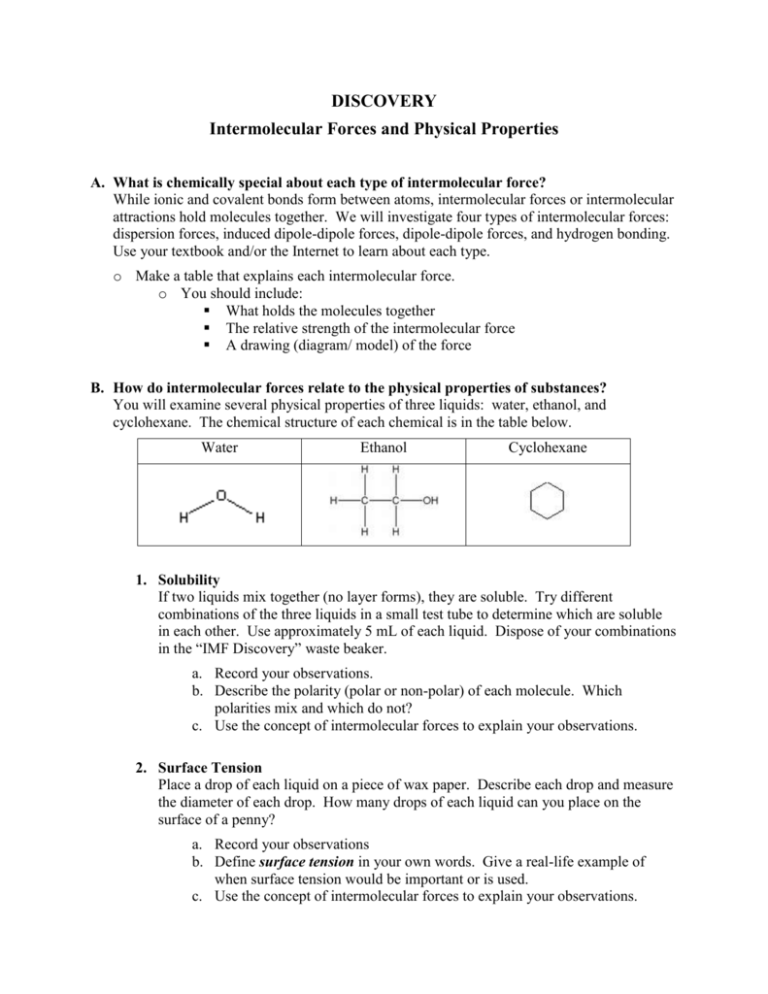
DISCOVERY Intermolecular Forces and Physical Properties A. What is chemically special about each type of intermolecular force? While ionic and covalent bonds form between atoms, intermolecular forces or intermolecular attractions hold molecules together. We will investigate four types of intermolecular forces: dispersion forces, induced dipole-dipole forces, dipole-dipole forces, and hydrogen bonding. Use your textbook and/or the Internet to learn about each type. o Make a table that explains each intermolecular force. o You should include: What holds the molecules together The relative strength of the intermolecular force A drawing (diagram/ model) of the force B. How do intermolecular forces relate to the physical properties of substances? You will examine several physical properties of three liquids: water, ethanol, and cyclohexane. The chemical structure of each chemical is in the table below. Water Ethanol Cyclohexane 1. Solubility If two liquids mix together (no layer forms), they are soluble. Try different combinations of the three liquids in a small test tube to determine which are soluble in each other. Use approximately 5 mL of each liquid. Dispose of your combinations in the “IMF Discovery” waste beaker. a. Record your observations. b. Describe the polarity (polar or non-polar) of each molecule. Which polarities mix and which do not? c. Use the concept of intermolecular forces to explain your observations. 2. Surface Tension Place a drop of each liquid on a piece of wax paper. Describe each drop and measure the diameter of each drop. How many drops of each liquid can you place on the surface of a penny? a. Record your observations b. Define surface tension in your own words. Give a real-life example of when surface tension would be important or is used. c. Use the concept of intermolecular forces to explain your observations. 3. Capillary Action Obtain capillary tubes that are labeled with the different liquids. Place one end of the tube into the appropriate liquid. a. Record your observations of the liquid level in the tubes. b. Define capillary action in your own words. Give a real-life example of when capillary action would be important or is used. c. Which liquid(s) rose the highest? Explain why using the concept of intermolecular forces. 4. Volatility Place a drop of each liquid on a glass plate. Observe the time it takes for the liquid drop to evaporate. a. Record your observations. b. Use the concept of intermolecular forces to explain your observations. C. What happens to intermolecular forces during a phase change? 1. Heating Curve Data Examine the heating curve of water below. Heating Curve of Water l 200 150 Temperature (oC) 100 50 0 -50 0 10 20 30 40 50 -100 -150 -200 Time (min) a. Indicate key temperatures on the graph. Indicate the state(s) of matter present along each major section of the graph (HINT: look at the temperature scale and remember when water freezes and boils). b. Draw a picture of what the water molecules look like in each section of your graph. Be as specific as possible. 2. Computer Data Visit the “Phase Change Experiment” website: http://www.chm.davidson.edu/ronutt/che115/Phase/Phase.htm. Read the directions about how to run the simulation. Use the simulation to answer the following questions. Include data from the simulations to support your responses. a. How are the liquid and vapor phases different from each other? What happens to the molecules in the liquid and vapor phases during a phase change? b. What impact does the strength of intermolecular forces have on a phase change? c. What happens to intermolecular forces during a phase change? What is your evidence? D. How can you turn powdered zinc oxide into an emulsion (solution) that could be used in a sunscreen? 1. Investigate how to turn zinc oxide powder into a solution. Be sure to record the methods used and amounts used. a. You have the following materials: paper cup/stirrer, zinc oxide, distilled water (10 mL), and Darvan-CN (2 mL) (2-propenoic acid, 2-methyl, ammonium salt, homopolymer). b. Investigate the impact water has on ZnO. What happens when water is added to zinc oxide? c. Investigate the impact Darvan-CN has on ZnO. What happens when Darvan-CN is added to zinc oxide? d. Investigate the impact of both water and Darvan-CN on ZnO? What happens when water and then Darvan-CN are added to zinc oxide? e. What do you think caused the ZnO powder to become difficult to stir in one case? Explain. f. Explain what may have happened when the Darvan-CN was added? g. Draw a picture (model) of what is occurring. E. Why are some sugars easy to clean up and others hard? 1. How are the sugar particles different? 2. How do they behave when a spoonful of sugar is placed on cardboard covered in black contact paper? 3. How do they behave when the sugar is dumped off the cardboard? 4. What is left on the cardboard? 5. Explain in terms of intermolecular forces (and potentially another force) why there was a difference observed in the falling of the sugars. LAB Mystery Chemicals Background Information: Dr. Nye was cleaning the chemistry storeroom. He found five bottles of chemicals in the back of the cabinet. The labels (hexane, acetone, butanol, water, and glycerin) from these bottles had fallen off the bottles and onto the shelf. He needs your help to identify the unknown liquids, so that he can correctly label the bottles. You will need to test the physical properties of the five unknown liquids to correctly identify them. Pre-Lab Questions: 1. Draw the chemical structure for each of the unknowns (use any resources you need). 2. Use the chemical structures to predict if each unknown is polar or non-polar. Provide an explanation for your predictions. 3. Use the chemical structures to determine the type of intermolecular forces present in each unknown liquid. 4. Based on the chemical structures and your knowledge of intermolecular forces, rank the unknown liquids from lowest boiling point to highest boiling point. Provide an explanation for your prediction. Procedure: o Develop a procedure to determine the correct identity of the five unknown liquids. Perform at least three tests on each liquid to verify your results. You will have the following test reagents and materials provided for you. If you need something special, see your teacher. You may NOT use taste or touch as one of your tests. 5 unknown liquids (labeled A, B, C, D, E) in dropper bottles test reagents in dropper bottles: water, cyclohexane, ethanol glass slides or plates small test tubes in a test tube rack graph paper stopwatch metric ruler capillary tubes wax paper Data Table: Create a data table to record the measurements/observations you will make in your experiment. Conclusion: Include the following information in your written conclusion. Identity each unknown liquid. Provide evidence from your experiment that confirms your conclusions. Compare your conclusions with the predictions you made in the Pre-Lab Questions. Discuss any differences between your predictions and experimental results. For each test you conducted on the liquids, discuss how intermolecular forces were involved. APPLICATION ASSIGNMENT How are intermolecular forces used by the macroworld in a nanosense? The following assignments investigate how intermolecular forces are involved in nanoscience and nanotechnology. The gecko uses nanoparticles and intermolecular forces to perform amazing stunts. Zinc oxide powder particles range from 200-800 nm in diameter. Part 1: Answer each initial question with referring back to your investigation. Turn in your answer, then you will get the article and have access to the Internet to complete Part 2. Part 2: Refer back to your data and observations from the discovery or complete a new investigation if you need further information. Then, prepare a presentation that you can do for either this class or another class (an elementary classroom or for parents). The presentation should include enough information to answer the questions and incorporate intermolecular forces. You may also want to consider bringing activities for the presentation so that students can understand the presentation in more depth. 1. How can a gecko walk upside-down on a ceiling? To assist in answering this question, refer back to the investigation of the “stickiness” of granulated sugar and powdered sugar. Read about “gecko glue.” http://www.hero.ac.uk/uk/business/archives/2003/sticking_with_gecko_glue5188.cfm ?view=print. List the main points about the article. Investigate on the Internet how geckos can walk upside-down on a ceiling. Why is it so important that nanosized materials are used? 2. How can you turn powdered zinc oxide into a solution that could be used in a sunscreen? To assist in answering this question, refer back to the investigation of turning zinc oxide powder into a solution. Investigate the strange attractions simulation “Duckboy in Nanoworld.” http://www.sciencemuseum.org.uk/antenna/nano/. What was the main point of the simulation? Investigate on the Internet what the purpose of zinc oxide is in sunscreen. Why does it have to be nanosized? 3. How do Geckos and Zinc-oxide sunscreen relate?

